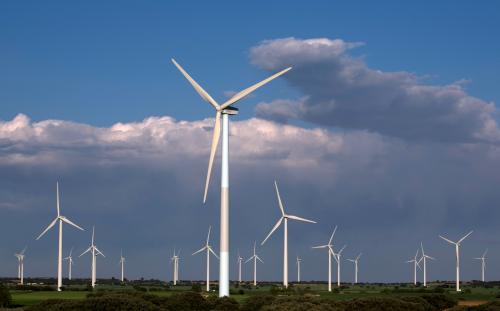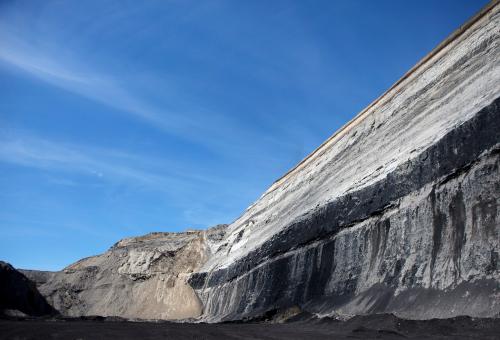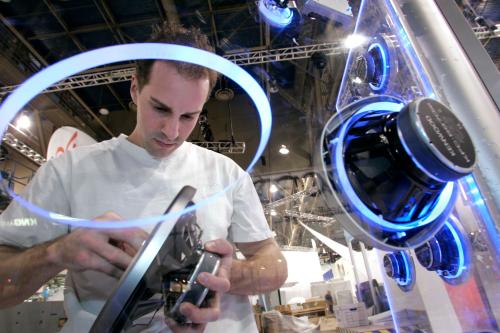President Trump is right about one thing: Energy industries are important to “making America great again.”
Moreover, Energy Secretary Rick Perry and Secretary of State Rex Tillerson are each on record with another appropriate point: Energy innovation matters hugely to America’s future.
Energy innovation matters hugely to America’s future.
The reason: Energy innovation represents a gargantuan $1.4 trillion global business opportunity, with more up-side on the way. The bottom line: Low-carbon technology holds great potential to spark high-quality growth in U.S. regions, support the manufacturing sector, and improve the trade balance.
And yet, there is a problem. At just the moment when some indicators suggest the U.S. clean energy innovation enterprise may be hitting a flat spot, the Trump administration has proposed draconian federal budget cuts that raise new concerns about the future of the nation’s commitment to low-carbon economic development.
These cuts, proposed through Trump’s “skinny budget,” could have serious repercussions for virtually all of the nation’s energy innovation programs. And so it is an urgent moment for the U.S. cleantech innovation enterprise, both nationally and regionally, which is why we have just released the first of two trend briefs on the state of U.S. low-carbon innovation. (Explore the data interactive here)
Focused on the pace and nature of cleantech invention (a forthcoming analysis will examine venture capital dynamics), our new analysis looks at technology patenting activity as a key indicator of clean energy innovation activity—and the health of the overall low-carbon sector.What do the data show? Overall, our numbers provide a mixed picture of a sector at an important juncture that policymakers should take cognizance of and take care not to further disrupt. Five trends jump out:
- U.S. cleantech patenting has grown significantly since 2001, outpacing growth in all U.S. patents, but may now be flagging. Since 2001, the total number of granted patents in the cleantech sector has more than doubled—from a little less than 15,000 in 2001 to approximately 32,000 in 2016. But there has been a downward trend in the number of cleantech patents granted in the country since 2014.

- U.S. cleantech patenting is concentrated in relatively few technology categories. Advanced green materials, energy efficiency, and transportation each accounted for 18 percent of total cleantech patenting between 2011 and 2016, while energy storage accounted for another 15 percent. Drastically fewer patents are being granted in such areas as geothermal energy, hydro & marine power, and nuclear generation.

- U.S. cleantech patenting is both concentrated in large metropolitan areas and widely distributed across diverse regions of the country. Just 10 metro areas ranging from Boston and Detroit to Houston, Minneapolis, San Francisco, and San Jose accounted for 38 percent of the cleantech patents developed by U.S. inventors since 2011, while 20 metro areas accounted for 52 percent. At the same time, cleantech patenting is widely distributed across red and blue states and big and small metros in every region.

- The nation’s metro areas, both big and small, display distinctive profiles in cleantech patenting. Whether it is large metros such as Detroit specializing in transportation and storage patents, or Houston in conventional fuels, or smaller metros such as Ames, Iowa in bioenergy and Wilmington, N.C. in nuclear, a large number of America’s metropolitan area with distinctive industry clusters are functioning as globally significant innovation hubs.

- The share of U.S. cleantech patents owned by foreign companies has grown over the years, raising concerns about the global competitiveness of U.S. companies. Foreign multinationals own a significant number of the cleantech patents that are granted by the U.S. Patent and Trademark Office every year, reflecting the globalization of cleantech industries, particularly in developed and developing Asian economies urgent about reducing carbon emissions and cornering growing markets for cleantech.

Given the size of the global clean energy economic opportunity, the United States can ill afford to relinquish its lead on innovation in the burgeoning global cleantech market to China or other countries. For that reason, Congress should set aside the skinny budget and draw on years of bipartisan support for energy innovation to coalesce around a core list of minimum viable supports for low-carbon innovation and growth. Most crucial will be provisions to maintain clean energy research and development appropriations at viable levels; maximize the impact of the nation’s 17 national energy laboratories; and preserve the Advanced Research Projects Agency-Energy (ARPA-E) while maintaining and scaling up the nation’s energy innovation hubs and institutes. For their part, states and regions must step up to invest more robustly in their own low-carbon innovation, and the private sector must argue more forcefully for essential federal supports even as it moves to shoulder more of the burden itself.
In sum, Congress as well as the private sector, states, and regions stand at a critical juncture this spring. With the economic potential of cleantech innovation widely acknowledged, the question has become: will the U.S. compete?







Commentary
Patenting invention: Five clean energy innovation trends Congress should know about as it weighs Trump’s ‘skinny’ budget
April 26, 2017